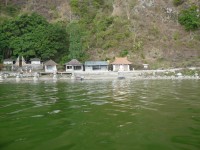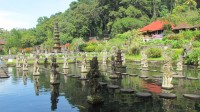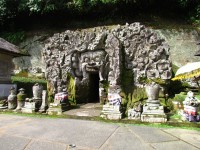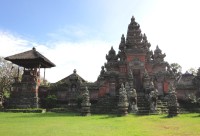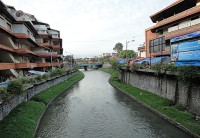Loading...
Pura Besakih temple, Bali
Turistické cíle • Ostatní • Ostatní
My guide Mahamuni said : “Pura Besakih. We call it the Mother Temple. It’s the most sacred place in Bali. Brahma, Visnu, and Siva arershiped there.”
“Wow!” I said. “That’s what I’ve wanted to hear. Is it also several hundred years old, like the other temples we’ve seen?”
“No,” Mahamuni said. “It’s 17 hundred years old.”
I was speechless. “That’s the proof I need,” I finally said. “It would support the Bhagavatam, which says Vedic culture was once worldwide.”
“It takes some time to get there,” Mahamuni said. “It’s on Mount Agung, a live volcano. But don’t worry. The last time it erupted was in 1964. Many tourists go to see the temple although there are some places they are not allowed. It’s actually a large complex of many temples, like a small version of Angkor Wat in Cambodia.”
“We should go tomorrow,” said Padma Locan. “It’s an auspicious day.”
“There is a festival there every six months,” said Mahamuni. “Many Balinese make the pilgrimage on those days to pray. The people believe that God spared the temple during the eruption. The lava came within meters of the temple complex but caused no damage to any structures. Nearby, entire villages were wiped out. One thousand people perished.”
That evening there was a program in ISKCON’s Sandipani Muni temple in Denpasar. When I arrived, hundreds of devotees were waiting.
“Wherever we have a program, there are so many blissful devotees,” I said to Padma Locan. “How many devotees do we have in Bali?”
“More than 2,000,” he said with a smile.
In the lecture I again discussed how all beauty in this world is temporary and ultimately has to be renounced. But I stressed that real renunciation was engaging everything in God’s service and that the devotees should use the natural opulence of the island to glorify Krsna.
After class a devotee approached me and said, “We dovetail the beauty of our beaches by going on Harinamas there every Saturday and having kirtan for the tourists.”
When he showed me his photographs, I was surprised to see Australian and European tourists chanting Hare Krsna and dancing with the devotees on the beach. I congratulated him for bringing spiritual life to the attention of the sun seekers.
Early the next day we left for Pura Besakih. On the long drive through mountainous terrain covered by jungle on all sides, I marveled that worship at the temple had been continuing for 1,700 years. I could hardly wait to take in the surroundings and the opportunity to find evidence of a Vedic connection in Bali’s past.
Eventually we arrived at a parking area one kilometer from the temple.
“The tradition is to walk the last kilometer,” said Padma Locan. “Walking up the hill provides time to reflect on the greatness of God and how we are His humble servants.”
The climb was steep, and it was hot and humid. I struggled on the last part until we crossed over a little rise. Suddenly the gigantic temple came into view, framed by the beauty of the jungle behind it.
“My God!” I exclaimed. “I’ve never seen anything like this.”
We walked the final 200 meters and after catching our breath continued up a long flight of steps leading to the First assortment of temple structures. The antiquity of the site was overwhelming.
“I feel like I’m in another age,” I said to Padma Locan.
As we were walking we could hear priests making offerings in the temples. Like the other temples I had seen in Bali, they were not closed structures but open-sided and approachable from all angles.
“You won’t find deities here,” said Padma Locan. “It’s different from India. They say the gods come only when they are being worshiped.”
As we walked around the large complex, I was awestruck by the unique architecture. Finally we came to an opening that led into a vast courtyard where I could see many priests offering oblations.
“Tourists can’t go in, only the faithful,” said Padma Locan, “and beyond here, where they worship the demigods, is the temple of Visnu.”
“That’s what I came to see,” I said eagerly. “I’m dressed as a sannyasi. Will they let me through here?”
“We can try,” he said.
I put my hand in my beadbag and started chanting loudly as we entered the compound. Padma Locan put a traditional Balinese hat on my head. As we walked into the large courtyard, several priests looked at me suspiciously. I chanted louder.
Suddenly, halfway across the compound, an elderly priest approached and said something in Balinese to Mahamuni.
“Oh, well,” I thought, “it was a good try.”
Mahamuni turned to me and smiled. “If you want to pass through this complex,” she said, “you must pray to the demigods.”
The priest put out a mat with several items of worship including incense, a candle, fruit, and spices.
“He wants you to offer these to the demigods,” said Mahamuni.
“A strict Vaisnava doesn’t worship demigods,” I thought as I recalled the words of Narottam das Thakur:
“O brother, I say to you, if you want to become a pure devotee of the Supreme Lord do not hanker for benedictions from the demigods.”
[Prema Bhakti Candrika]
“But if I don’t offer some worship,” I thought, “I’ll never make it to the temple of Lord Visnu.”
The priest was becoming uncomfortable with my hesitation. Suddenly I had an idea.
“Okay,” I said. “I’ll sit and pray to the demigods.”
By Krsna’s grace I had been reading the 10th canto of Srimad-Bhagavatam and had recently memorized a prayer that seemed perfect for the occasion. I bowed down to the nearest altar and then sat up. I lit the incense, offered it, and prayed:
katyayani maha maye maha yoginy adhisvari nanda gopa sutam devi patim me kuru te namah
“O goddess Katyayani, O great potency of the Lord, O possessor of great mystic power and mighty controller of all, please make the son of Nanda Maharaja my husband. I offer my obeisances unto you.”
[Srimad-Bhagavatam 10.22.4]
The priest was impressed and after giving us some caranamrita, happily sent us on our way to the temple of Visnu.
“What was the object of your prayer?” said Mahamuni.
“I repeated a prayer of the gopis,” I said, “but nothing I’ll achieve in this lifetime.”
We continued walking through the courtyard and then up several flights of steps, finally reaching the top of the hill on which the entire temple complex was situated. From there we had a direct view of Mount Agung.
“It must have been terrifying when the volcano exploded,” I said.
“It’s still very active,” said Padma Locan. “From time to time it belches thick smoke and ash. It’s only a matter of time until it explodes again.”
“Hopefully not today,” I said with a nervous smile.
We turned left, and walking a further 50 meters along a stone path finally came to the temple of Lord Visnu. As we entered I was surprised to find we were the only pilgrims there.
“They worship Siva as supreme here in Pura Besakih,” said Mahamuni, “not Visnu.”
“I’m sure it wasn’t always like that,” I said. “Just look at this magnificent temple, the intricacy of the stone work. At some point Visnu must have been the principal deity here.”
Suddenly from around the back of the temple an elderly man appeared, dressed in white.
“The priest,” whispered Padma Locan.
He offered a bowl of fruit on the altar to Visnu and said some prayers. I waited patiently and when he was finished approached him.
With Mahamuni translating I spoke. “Sir,” I said, “we are devotees of Lord Visnu, or Krsna. We are pleased to see you making an offering to Him with such devotion.”
He humbly bowed his head but didn’t say anything.
“How long have you been a priest at this temple?” I said.
“Since I was a boy,” he replied. “My father was a priest here, and his father and his father . . .”
“How old are you?” I asked.
“Eighty-three,” he replied.
“You don’t look that old,” I said.
“A lady who lives in my village is 225 years old,” he said. “She was born in
1783.”
Padma Locan’s eyes opened wide in astonishment.
“In previous generations, many people here lived for well over 200 years,” the priest continued.
“How was it possible?” I asked.
He chuckled. “They worked hard in the fields,” he said. “They drank water from the streams, they ate mainly rice and vegetables, and they visited this temple every day.”
“Visited the temple every day,” I repeated, trying to understand how that was connected to longevity.
He smiled. “They were happy,” he said, “but none of us will live forever. What’s important is where you’ll go when you die.”
“Where do you hope to go when you die?” I asked, eager for the realization of one who had served the Lord his entire life.
He paused for a moment looking at the altar. “With Him, of course,” he said.
The priest fell silent, and just at that moment it started to rain.
“We have to go,” I said. “Your darsan was worth the entire trip here. We’re happy to have seen this ancient temple which stands as evidence that India’s spiritual culture once reached far beyond its present borders and, most important, is still producing men of your caliber, full of faith in God.”
Srila Prabhupada writes:
“In the modern age people are under the impression that during the Vedic period America and many other parts of the world had not been discovered. But that is not a fact. Prithu Maharaja ruled over the world many thousands of years before the so-called prehistoric age and it is clearly mentioned here that in those days not only were all the different parts of the world known, but they were ruled by one king. It is clear that the kings of India once ruled all the world and that their culture was Vedic.”
[Srimad-Bhagavatam 4.21.12, purport]
Indradyumna.swami@pamho.net www. traveling-preacher. com Audio lectures: www. narottam. com
Příspěvky z okolí Pura Besakih temple, Bali


